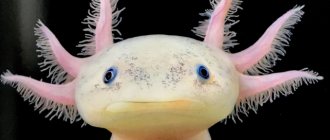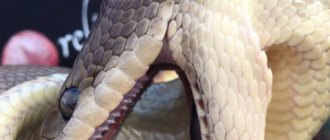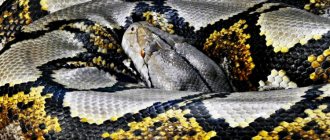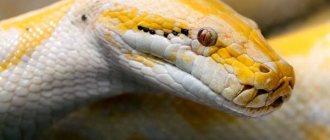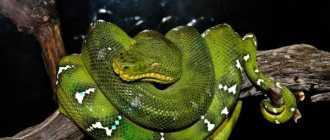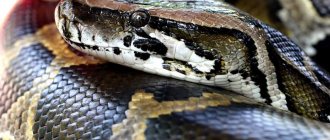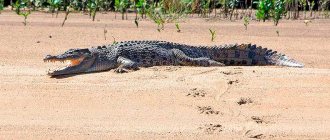Description of the carpet python
A small snake among pythons looks almost like a dwarf, but it is elegant and very beautiful, usually weighs from 1 to 3 kg, the pattern on its body resembles bright oriental carpets, which was the reason for its unusual name. In scientific circles, a slightly different name is used - Morelia Spilota, and these pythons are also called rhombic pythons.
This is interesting! The first word of the Latin name means both slow and stupid, a simpleton, apparently due to the peculiar structure of the head, thanks to which the muzzle looks stupid - surprised.
Carpet pythons reach 2 meters in length. Snakes can be colored in dark, light brown, or caramel colors, but all individuals of the species have a clear contrasting pattern on the body in the form of spots or stripes. The shades and intensity of color are related to their habitat, because thanks to the iridescence of their scales, pythons become completely invisible, dissolving among stones or trees.
Types of carpet python
The snake, which lives in southwestern Australia, is called the tile snake due to the structural features of its scales, which are very similar to this building material . They are also called imbricates. A little yellow, brown spots with clear “mourning” frames - this is how these pythons camouflage themselves in bushes growing on rocky shores and low-growing vegetation. Rarely does the weight exceed 1 kg, the maximum length is 190 cm.
Depending on the color, size, and habitat, carpet snakes are divided into six subspecies:
- One of the most beautiful among miniature pythons is the diamond python, shimmering with all the colors of the rainbow. These beauties can often be found in terrariums, but in nature they are found very rarely in a limited area. Among the diamond beauties, there are specimens with a length of 280 cm, the record being 310 cm.
- The McDowell python is distinguished by pastel tones in color and an almost complete absence of dark color in the pattern. These carpet snakes are large, they can reach up to 2.5 m.
- Medclough's carpet python grows up to 190 cm, prefers the states of Victoria, Northern Territory, South Wales in Australia.
- The Cheney is the most common species of python kept in captivity. They are loved for their wonderful yellow color, on which black spots are scattered, forming a pattern. Cheney grow no more than 2 m, are tamed quite simply and look impressive. On the head of these pythons you can see a pattern resembling a skull.
- The mottled python, also called iridescent, is called variegated and is loved by many terrarium owners. They are quite large, can grow up to 2.5 m. Light with dark spots that change color from red to dark brown. Contrasting spots seem to fade with age, the coloring becomes soft and non-aggressive.
- The New Guinea carpet snake is found both in the forests of Guinea and Australia; it likes to settle near water. Born reddish-brown, pythons acquire their stunning black and yellow coloration as they age. There are pythons that have shades of banana, caramel, red, the spots can be small and large, the merging resembles Chinese characters.
These species are the main ones in the classification of carpet pythons, which in nature are tough and intelligent predators, and in terrariums they are exotic, albeit slightly dangerous pets that are particularly charming and quite easy to keep.
Lifestyle, behavior
Carpet snakes lead a rather secretive lifestyle, choosing places to hunt in wooded areas, wetlands, and near water bodies. They are almost never found in deserts, but they crawl well in trees, although they are also agile on the ground. They love to catch prey from ambush, and their forked tongue helps them catch the scent of the prey . Jumping out of cover with lightning speed, the python wraps itself around the prey it can handle, its strong body contracts, strangling the prey, breaking its bones. Sharp teeth also help pythons hold and kill.
Important! Pythons can bite, but they are not poisonous.
Having killed and swallowed prey, the snake digests it up to 8 days, and if the ambient temperature is low, then 20-25 days. Temperatures below 25 degrees become low for reptiles. Even then the snake begins to warm itself by contracting its muscles. The tenacious tail helps not only to move, but also to hang on trees for a long time, entwined in half rings and resting.
Pythons are excellent swimmers; you can see them in the rivers of Australia and New Guinea very often, since the population of carpet snakes is distributed over a large area. They extremely rarely attack people, but they may well climb into their warm homes to hunt mice and rats.
Lifespan
Carpet pythons live quite a long time. In nature, the period reaches 15-17 years, and in captivity with good care it is 25-27 years.
Return to content
Subspecies [edit]
The geographical distribution and common names can be summarized as follows, although M. s. imbricata missing: [4] [11]
| Subspecies [4] | Author of taxon [4] | Common name | Geographic range |
| RS. Cheney Jungle Carpet Python - in the barn. | Wells and Wellington, 1984 | Jungle carpet python | Australia in northeast Queensland |
| RS. Mcdowelli Australian carpet python | Wells and Wellington, 1984 | Coastal carpet python | Australia in eastern Queensland and northeastern New South Wales |
| RS. Metcalfei Murray expensive python carpet treatment | Wells and Wellington, 1984 | Python interior carpet | Australia in the Murray-Darling Basin in Queensland, New South Wales, Victoria and South Australia |
| RS. Spilota Diamond Python in Lamington National Park, Queensland, Australia | (Lacepede, 1804) | Diamond python | Australia in eastern New South Wales and far eastern Victoria |
| RS. Variegata Morelia spilota variegata | Yegray, 1842 | Darwin carpet python Irian Jaya carpet python Papuan carpet python Rubber python | New Guinea (Western New Guinea and Papua New Guinea) and Australia in northwestern Western Australia and northern Northern Territory (specimens from New Guinea are referred to as M. harrisoni , but this is not officially recognized as a distinct species or subspecies) |
Hybrids[edit]
- Morelia spilota X viridis
Diet, prey
Pythons are carnivorous snakes; they are not satisfied with plant foods . Lizards, rodents, rabbits, birds, as well as frogs and fish become prey for these snakes. Often the victim is much larger than the snake’s head, but the jaws, designed in a special way, allow the mouth to open much wider than expected, literally stretching over the food and pushing it inside the body.
The digestion process, during which the python hardly moves, lasts a long time - from 7 to 30 days.
Return to content
Hunting
Like most snakes, pythons do not chase their prey. They hunt from ambush, waiting for the prey to come closer. Carpet pythons use vision and smell to catch prey. These snakes also have the added advantage of special temperature-sensitive openings along their jaws, or “pits,” that can trap heat if prey is close. They find warm-blooded prey even in the dark or among dense foliage.
The python is not poisonous, it is a constrictor. The snake grabs the prey with its teeth, then quickly wraps its body around it and squeezes. The python does not break her bones or crush her. He squeezes with such force that the victim cannot inhale air. Every time she exhales, the constrictor tightens its rings, taking the place of the released air and causing suffocation. The python senses the beating of the prey's heart, and when it stops, the snake opens its coils to release the prey and swallow it.
Natural enemies
Few creatures are able to take on a giant and very strong snake, but birds of prey, wild cats, crocodiles and other large animals often attack young specimens. Not only birds, but also lizards and rodents can destroy a nest with eggs.
Attacks from above are especially dangerous for snakes, which they very rarely manage to repel. Storks, eagles, kites, noticing a small snake moving across an open area, fall like a stone, spreading their claws, grab the snake and lift it high into the sky. And then they simply let go - the snake breaks, the predator calmly eats the prey.
Return to content
Snake behavior
The carpet snake is usually active at night and spends most of the day coiled on a tree, roof rafters, or sprawled out in open areas.
Pythons move forward in a straight line, which is known as "rectilinear progression", using their body mass. This type of movement works both on the ground and in trees. Pythons cannot move very fast - only about 1.6 kilometers per hour on level ground.
Reproduction and offspring
Pythons are called pseudopods because of the rudiment - processes in place of the hind legs. Rubbing them against the female during courtship, the python scratches and fertilizes her with the help of anal spurs.
The female lays eggs only when she is full of strength and there is plenty of food around. The number of eggs in a clutch also depends on how favorable the conditions are. Having laid the eggs, the female wraps herself around them and does not leave the clutch for a minute. By raising the temperature of her own body with muscle movements, the mother python maintains the temperature inside the rings 15-20 degrees higher in cold weather.
The snake does not eat anything for two months of incubation, and then helps the babies to be born. These “babies” can be up to 50 cm in length. They are fully formed and can take care of themselves, feeding on small lizards and frogs, and birds. They can destroy nests, eating eggs and chicks, adapting to the environment and are aggressive.
Carpet snakes reach sexual maturity at 3-5 years, and by 5 years the females are ready to lay eggs.
Return to content
Lifespan
Pythons are long-lived, hardy species; the maximum average lifespan will depend on the species. On average they live from 15 to 30 years. The record for longevity belongs to the ball python, which lived to be 48 years old.
Here are the maximum recorded lifespans of some of the most commonly kept snake species in pets and zoos:
- carpet python – 19.6 years;
- green tree python – 20.6 years;
- Children's python – 25.7 years;
- Sumatran short-tailed python – 27.8 years;
- reticulated python – 29.4 years.
Keeping a carpet python at home
There are many carpet snake lovers who prefer to admire them not in zoos, nurseries and in the wild, but at home.
Pythons are unpretentious; in terrariums it is necessary to maintain the temperature and humidity characteristic of the jungle, and feed them with live or frozen food. Pythons are easily tamed, recognize their owners, some are inclined to “communicate”, but there are also those with a closed character. It is worth studying your pet well so that you can pick it up without risk.
Humans are very large prey for carpet beauties, so they are unlikely to attack . But being bitten by sensing a threat or the smell of food (if the person who took the snake was holding a mouse in their hands before) can be very painful. It is better to learn about the peculiarities of care from specialists or previous owners, because changes in diet, temperature fluctuations, and molting patterns can destroy both a young python and an older individual.
We must never forget that a cute pet is a predator that requires special attention. And then communication with him will be very pleasant.
Return to content
Nutrition
The python begins the slow process of opening its jaw and swallowing its prey whole, usually head first. The prey passes through the esophagus, thanks to rhythmic muscle contractions that push it down, from the snake's throat into the stomach. How does the snake breathe at this time? The python has a special tube at the bottom of its mouth through which it can do this.
After eating, pythons look for a warm place to rest while their food is digested. Snakes are most vulnerable after a large meal, when they are less likely to move quickly.
When threatened, some pythons curl into a ball and draw their heads into their coils; other species may try to escape, get into a striking or "S" position, or use their constricting force.
Carpet pythons primarily feed after dark and eat small animals such as rats, possums and birds. Smaller individuals prefer to feed on lizards.
Payment
- For pickup: Cash or online transfer to a Sberbank card;
- When delivered by courier service in Moscow and the region: Cash to the courier or advance payment to a Sberbank card;
- For delivery to a pick-up point: Payment on site at the pick-up point.
- When paying for an order by bank transfer, it is necessary to send confirmation of payment to the postal address [email protected]
Reservation of goods/animals
In our store you can reserve a product or animal with full prepayment.
- Money is NOT refunded if you refuse the product for personal reasons (for example, you change your mind);
- The money is returned in case of a product malfunction, non-compliance with the declared product, or a long absence of the product in stock.
After full payment for the animal , it is reserved for you for up to 10 days . After 10 days, each subsequent day of overexposure costs 200 rubles . If the animal is delayed in the store due to our fault (there is no way to send it, the animal is in quarantine, etc.), no amount will be charged for the overexposure.
